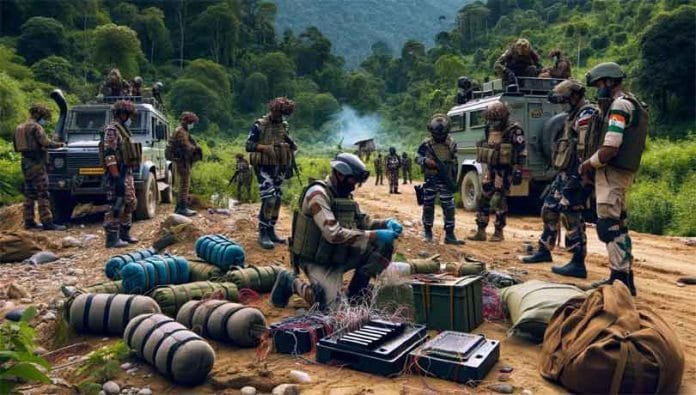INVC NEWS
New Delhi : The security landscape in Jammu and Kashmir has seen a dramatic shift in recent years, particularly since the abrogation of Article 370 in 2019. As of September 27, 2024, a total of 23 terrorist incidents have been reported, a significant reduction compared to 2014, when 222 attacks were documented. According to officials, this sharp decrease in terrorist activities has directly impacted voter turnout, particularly in regions previously marred by violence. While this improvement in security is welcomed, the statistics reveal some crucial insights into the region’s evolving security situation and its effect on the electoral process.
A Tenfold Decrease in Terrorist Incidents Since 2014
In 2014, Jammu and Kashmir witnessed 222 terrorist attacks, underscoring the volatile situation at the time. Fast forward to 2024, and the number has plummeted to just 23 incidents. Out of these, 15 occurred in the Jammu region, while 8 incidents were reported in Kashmir. This reduction represents a nearly tenfold decrease in overall terrorist activities, suggesting a significant improvement in security operations and intelligence capabilities. This is particularly significant in the backdrop of the first assembly elections held after the abrogation of Article 370, which removed the special status of Jammu and Kashmir.
Security Personnel Casualties: A Decline in Numbers
Security personnel have borne the brunt of these terrorist attacks. In 2014, 47 security personnel lost their lives. By 2024, this number has been reduced to 23, with 17 deaths in Jammu and 6 in Kashmir. This decrease reflects better preparedness and enhanced counterterrorism strategies by Indian security forces, although the Jammu region remains more vulnerable than Kashmir. Despite this, the consistent efforts of the military and security agencies have undoubtedly played a critical role in stabilizing the region.
Civilian Casualties: A Grim Reality
Civilian deaths, though fewer, continue to be a tragic outcome of these terrorist incidents. In 2014, 29 civilians were killed, whereas in 2024, the number has dropped to 16, with 11 deaths in Jammu and 5 in Kashmir. This stark contrast in the distribution of casualties further highlights that Jammu has now become the more affected region, in comparison to the Kashmir Valley, which had traditionally seen the bulk of such violence. The reduction in civilian deaths is indicative of the government’s efforts to protect non-combatants, yet these numbers serve as a reminder that the terrorist threat is far from eradicated.
Voting Patterns and Terrorism: A Complex Dynamic
Interestingly, the decrease in terrorist attacks has not uniformly translated into higher voter turnout. In fact, voter turnout in the 2024 assembly elections has declined in most districts when compared to 2014. Out of the 13 districts that voted in the first two phases on September 18 and 25, eight recorded lower voter turnout. Five of these districts are in Jammu, while the remaining three are in the Kashmir Valley.
Only Reasi district in Jammu showed an increase in voter participation, despite having experienced the largest terrorist attack of 2024 in July, when terrorists opened fire on a bus, killing eight passengers and the driver. This attack shook the region, yet it appears to have galvanized voter participation rather than suppressed it. In contrast, districts like Poonch and Rajouri—which have seen an uptick in terrorist encounters—experienced a sharp decline in voting percentage, demonstrating the continuing influence of terrorism on voter sentiment.
The Impact of Terrorism on Election Turnout
The correlation between terrorism and election turnout has been a subject of intense discussion. The 2024 assembly elections were expected to see a higher voter turnout due to the improved security environment, yet this has not been the case for most regions. In Kashmir, where four out of seven districts (including former terrorism hotbeds like Kulgam, Shopian, Pulwama, and Srinagar) saw a better voter turnout compared to 2014, the narrative is different. These areas, once dominated by militancy, have benefitted from the reduction in terrorist activities, leading to an increase in electoral participation.
In Jammu, however, voter apathy seems to have set in, particularly in districts that have faced recent attacks. The contrasting voting patterns between the two regions underline the complexity of the security situation, where areas formerly riddled with terrorism now show greater voter confidence, while areas recently affected are showing growing apprehension.
Terrorists Neutralized: A Comparison of 2014 and 2024
The neutralization of terrorists is another crucial factor in assessing the security situation. In 2014, a total of 110 terrorists were eliminated, with Kashmir witnessing the majority of these operations. By contrast, 2024 has seen 45 terrorists neutralized—35 in Kashmir and 10 in Jammu. This decrease in terrorist neutralizations aligns with the overall decline in terrorist activities, as fewer incidents translate to fewer encounters.
Of the 35 terrorists killed in Kashmir, 18 were foreign militants and 17 were locals, showing the continued presence of foreign fighters in the region, although their numbers are dwindling. This shift demonstrates the growing success of security forces in controlling the infiltration of foreign terrorists, a major cause of unrest in previous years.
IED and Grenade Attacks: The Changing Face of Terrorism
The absence of IED and grenade attacks in 2024 marks a significant development in the region’s security landscape. In 2014, 23 grenade attacks and 9 IED blasts were recorded, along with 41 strike calls from separatist groups. The complete eradication of such incidents in 2024 is a testament to the effective counterterrorism measures and increased surveillance across sensitive areas.
The shift in tactics by terrorists, moving away from indiscriminate bombings towards targeted killings, indicates a change in their strategy, likely a result of heightened security and community vigilance. While this change has led to fewer casualties, it continues to pose a significant threat to the region’s overall stability.
Conclusion: A Safer But Not Fully Secure Future
The drastic reduction in terrorist incidents from 222 in 2014 to just 23 in 2024 is undoubtedly a sign of improvement in Jammu and Kashmir’s security situation. The efforts of the Indian security forces in combating terrorism have yielded measurable success, especially in areas like the Kashmir Valley, which have traditionally been centers of violence.
However, the Jammu region presents a new challenge, with increased terrorist activity and growing civilian and security personnel casualties. While voter participation in some areas has increased, the decline in turnout in districts affected by recent violence suggests that terrorism still influences the political process.
Going forward, it is crucial to sustain the momentum in improving security, while also addressing the regional disparities that have emerged. Only through continued vigilance, strategic interventions, and community engagement can the dream of a fully secure Jammu and Kashmir be realized.
















